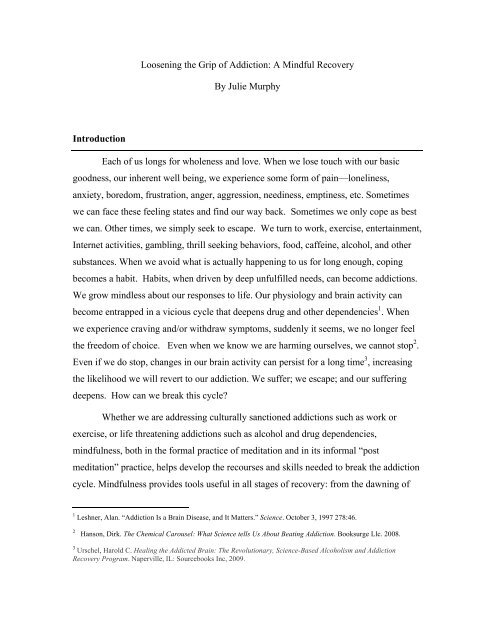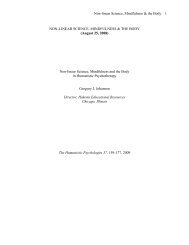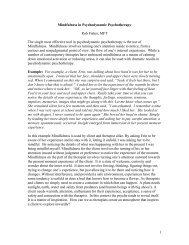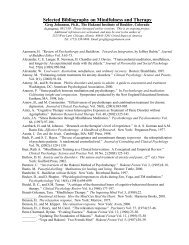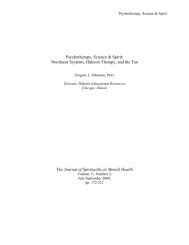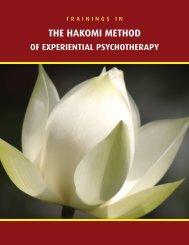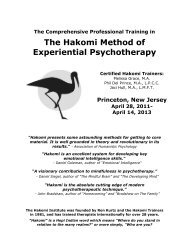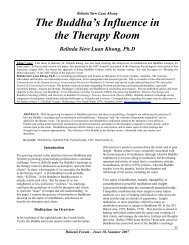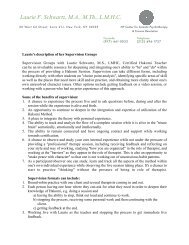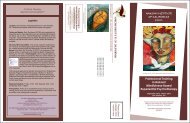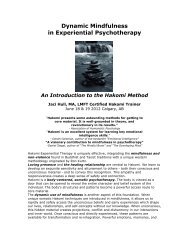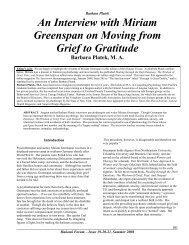Loosening the Grip of Addiction: A Mindful ... - Hakomi Institute
Loosening the Grip of Addiction: A Mindful ... - Hakomi Institute
Loosening the Grip of Addiction: A Mindful ... - Hakomi Institute
You also want an ePaper? Increase the reach of your titles
YUMPU automatically turns print PDFs into web optimized ePapers that Google loves.
<strong>Loosening</strong> <strong>the</strong> <strong>Grip</strong> <strong>of</strong> <strong>Addiction</strong>: A <strong>Mindful</strong> Recovery<br />
By Julie Murphy<br />
Introduction<br />
Each <strong>of</strong> us longs for wholeness and love. When we lose touch with our basic<br />
goodness, our inherent well being, we experience some form <strong>of</strong> pain—loneliness,<br />
anxiety, boredom, frustration, anger, aggression, neediness, emptiness, etc. Sometimes<br />
we can face <strong>the</strong>se feeling states and find our way back. Sometimes we only cope as best<br />
we can. O<strong>the</strong>r times, we simply seek to escape. We turn to work, exercise, entertainment,<br />
Internet activities, gambling, thrill seeking behaviors, food, caffeine, alcohol, and o<strong>the</strong>r<br />
substances. When we avoid what is actually happening to us for long enough, coping<br />
becomes a habit. Habits, when driven by deep unfulfilled needs, can become addictions.<br />
We grow mindless about our responses to life. Our physiology and brain activity can<br />
become entrapped in a vicious cycle that deepens drug and o<strong>the</strong>r dependencies 1 . When<br />
we experience craving and/or withdraw symptoms, suddenly it seems, we no longer feel<br />
<strong>the</strong> freedom <strong>of</strong> choice. Even when we know we are harming ourselves, we cannot stop 2 .<br />
Even if we do stop, changes in our brain activity can persist for a long time 3 , increasing<br />
<strong>the</strong> likelihood we will revert to our addiction. We suffer; we escape; and our suffering<br />
deepens. How can we break this cycle?<br />
Whe<strong>the</strong>r we are addressing culturally sanctioned addictions such as work or<br />
exercise, or life threatening addictions such as alcohol and drug dependencies,<br />
mindfulness, both in <strong>the</strong> formal practice <strong>of</strong> meditation and in its informal “post<br />
meditation” practice, helps develop <strong>the</strong> recourses and skills needed to break <strong>the</strong> addiction<br />
cycle. <strong>Mindful</strong>ness provides tools useful in all stages <strong>of</strong> recovery: from <strong>the</strong> dawning <strong>of</strong><br />
1 Leshner, Alan. “<strong>Addiction</strong> Is a Brain Disease, and It Matters.” Science. October 3, 1997 278:46.<br />
2<br />
Hanson, Dirk. The Chemical Carousel: What Science tells Us About Beating <strong>Addiction</strong>. Booksurge Llc. 2008.<br />
3 Urschel, Harold C. Healing <strong>the</strong> Addicted Brain: The Revolutionary, Science-Based Alcoholism and <strong>Addiction</strong><br />
Recovery Program. Naperville, IL: Sourcebooks Inc, 2009.
awareness an addiction problem exists, through <strong>the</strong> early stages <strong>of</strong> abstinence or harm<br />
reduction, to relapse prevention, advanced recovery and maintenance. We can use<br />
mindfulness to cultivate <strong>the</strong> capacity to calmly bear witness to our emotions, habits,<br />
reactions and responses. <strong>Mindful</strong>ness helps us recognize when we are vulnerable<br />
to yielding to our addiction. We can become aware <strong>of</strong> our somatic cues, including<br />
yearning, tension, compression, deadening and dissociation. We learn to recognize<br />
relapse cues so we can make o<strong>the</strong>r choices. We develop <strong>the</strong> resources to tolerate what we<br />
have not been able to tolerate. This helps us to get to what actually drives our<br />
unconscious urges. We can employ mindfulness to heal from our childhood wounds and<br />
make friends with our physiological predispositions and our defenses. When we have<br />
developed more resources and greater self-awareness, we can make more wholesome<br />
choices and stick to <strong>the</strong>m. We create a positive feedback loop that eases <strong>the</strong> destructive<br />
process, fostering loving self-care and self-discovery. <strong>Mindful</strong>ness cultivates <strong>the</strong> qualities<br />
<strong>of</strong> nonjudgmental awareness and fierce compassion that help us to free ourselves from<br />
<strong>the</strong> powerful grip <strong>of</strong> addictions.<br />
Vignette: Introducing Stephen<br />
Stephen was referred to me when he completed a thirty-day residential treatment<br />
program for alcohol in which he received a firm foundation and education about <strong>the</strong> brain<br />
disease <strong>of</strong> addition and cognitive behavior relapse prevention strategies. Stephen began<br />
using drugs and alcohol in junior high. His fa<strong>the</strong>r died <strong>of</strong> alcohol related disease; his two<br />
sisters drink heavily and frequently take party drugs on weekends. Stephen tried to “get it<br />
more under control” when his twins were born. Yet, he spent little time at home, working<br />
long hours in his start up business and meeting clients at <strong>the</strong> bar after hours. When <strong>the</strong><br />
twins turned three, Stephen finally realized he needed help. We began our work toge<strong>the</strong>r<br />
about five years later. At age forty, Stephen was highly motivated to give his sons a<br />
better childhood <strong>the</strong>n he had.
Vignette: Using <strong>Mindful</strong>ness to Manage Feelings <strong>of</strong> Loss Associated with Recovery<br />
I used Stephen’s present moment experience as a window to uncover a level <strong>of</strong> anger and<br />
defensiveness that colored his life and compromised his relationships:<br />
Early in our work, we focused on Stephen’s anger. He blew up over small things<br />
and railed against <strong>the</strong> unfairness that o<strong>the</strong>r people got to have fun (and drink) and he did<br />
not. The loss <strong>of</strong> certain activities and <strong>the</strong> places he had to avoid because <strong>the</strong>y triggered<br />
his desire to drink, caused him much aggravation. He also felt impatient with <strong>the</strong> lack <strong>of</strong><br />
his wife Lucille’s understanding. He was angry that his family would not talk about <strong>the</strong><br />
real nature <strong>of</strong> his fa<strong>the</strong>r’s disease.<br />
The anger was festering inside him yet he was unaware <strong>of</strong> it. Comments that I<br />
made, such as “You’re really mad about that, huh?” and “There’s a lot <strong>of</strong> energy as you<br />
tell me about this” and “your fists curl up as you’re talking, huh?” helped to pave <strong>the</strong> way<br />
for mindfulness. <strong>Mindful</strong>ness involves paying careful attention to <strong>the</strong> present moment<br />
without trying to change it or avoid it. I made contact with <strong>the</strong> actual emotions and<br />
energies in his body that lay just outside <strong>of</strong> his awareness to help him place his attention<br />
<strong>the</strong>re. He said, “Yes! I am mad,” with surprise in his voice. Then I slowed <strong>the</strong> process<br />
down and invited him to study <strong>the</strong> quality <strong>of</strong> <strong>the</strong> anger asking, “How about we study this<br />
feeling?” “Okay,” he said. Because his whole chest and arms and fists had tightened up,<br />
I invited him to notice those parts <strong>of</strong> his body, guide him into mindfulness. “It seems like<br />
something’s happening in your chest and arms,” I noted, “maybe you’d like to begin by<br />
just feeling into those areas in you body.” “Yes. There’s so much energy and tension<br />
<strong>the</strong>re,” he reported.<br />
As we slowly explored <strong>the</strong> sensations that accompanied <strong>the</strong> feelings, Stephen<br />
became less identified with <strong>the</strong> content <strong>of</strong> his story and more curious about his inner<br />
experience. His mindfulness deepened as he felt into <strong>the</strong> impulse to tighten his fists and<br />
raise his arms. I encouraged him to let <strong>the</strong> movement happen, but to slow <strong>the</strong> action<br />
down so he could study any thoughts, sensations, feelings, images, or memories that<br />
might be evoked as he did so. Stephen closed his eyes and very slowly began to tighten<br />
his fists and raise his arms over his head. His whole ribcage expanded as he did so. “I’m<br />
like a grizzly bear,” he told me. “I want to growl…I’m ready for a fight.” “Would it be
okay just to stay with all <strong>of</strong> that, <strong>the</strong> tension, <strong>the</strong> urge to growl, <strong>the</strong> readiness?” I asked.<br />
“Without trying to think about it, just let yourself steep in <strong>the</strong>se impulses and sensations;<br />
let’s just see where this image <strong>of</strong> a bear ready to fight takes you.” Stephen quietly studied<br />
his experience for a moment and <strong>the</strong>n a look <strong>of</strong> sadness crossed his face. His body<br />
relaxed as he said, “There’s just so much loss… I don’t know how to deal with it… It<br />
scares me… And now I’m scaring everyone around me.” This insight allowed us to<br />
fur<strong>the</strong>r process his underlying feelings <strong>of</strong> loss and fear and his emotional strategy to<br />
protect himself by becoming this grizzly bear.<br />
Stephen was able to use <strong>the</strong> somatic cues <strong>of</strong> tension in his arms and fists to alert<br />
him to underlying feelings he avoided. When he paid attention to <strong>the</strong>se feelings, his<br />
blow-ups at home and work began to diminish. When he could share his genuine feelings<br />
with his wife, she became less defensive and more understanding. Her understanding<br />
helped Stephen feel safer. His growing calmness allowed her to be more receptive to him.<br />
Through processing his emotions in mindfulness and extending that awareness in his<br />
daily life, Stephen was already creating positive feedback loops within himself and with<br />
his wife.<br />
Vignette: Working with Relapse Cues<br />
<strong>Mindful</strong>ness can be used as a tool to enhance and imbed natural resources:<br />
Winter was coming, and with it, ski season. “Ever since I was 13,” Stephen<br />
remembered, “we’d go up to <strong>the</strong> slopes with a flask and a few joints. I can’t imagine not<br />
doing it that way. I don’t know what to do. Luce and <strong>the</strong> boys have <strong>the</strong>ir hearts set on it.”<br />
“It’s pretty confusing, huh?” I commented. He nodded and said, “I just want to go and cut<br />
loose and have <strong>the</strong> fun I used to, but I know that’s not what I really want. It’s just going<br />
to be really hard not to at least grab a beer at <strong>the</strong> lodge.” “How about we try a little<br />
experiment in mindfulness to study all <strong>of</strong> this?” I asked. “Sure, I’m game,” he said.<br />
I guided Stephen into his inner experience, just noticing without judgment<br />
whatever thoughts, images, feelings, mood, sensations, or impulses were already<br />
happening. When he was ready, he gave me a nod. Using all his senses, I asked him to
imagine getting on his boots and skis and standing in <strong>the</strong> snow. “The first thing I notice,”<br />
he reported, “is <strong>the</strong> smell <strong>of</strong> <strong>the</strong> forest. The air is so fresh…” “Great,” I said. “How<br />
about you just let yourself breath in and smell <strong>the</strong> air?” “Wow,” Stephen commented, “I<br />
never knew how much I love just this. The trees and <strong>the</strong> air and <strong>the</strong> blue sky.” His whole<br />
body relaxed as he remembered and imagined. “You relax, huh?” I contacted this present<br />
experience. “Yes, I feel so alive even thinking about it. It’s like I’m really <strong>the</strong>re. The<br />
pine trees are so tall and straight. I feel myself straighten up as I look at <strong>the</strong>m.” I<br />
encouraged Stephen to deepen into <strong>the</strong> feeling <strong>of</strong> aliveness, connecting with this somatic<br />
experience <strong>of</strong> straightening as he did so. A big smile appeared on his face. “It feels<br />
really good,” I said. “Yes!” he responded and his smile grew even bigger. “I feel really<br />
good in myself…Like I’m ok (he relaxes more)…And I’m looking at <strong>the</strong> slopes and feel<br />
really excited. I can’t wait to get up <strong>the</strong>re.” I encouraged Stephen to stay with his<br />
positive feelings and sensations, to feel deeply into <strong>the</strong> smile on his face. After a few<br />
moments he told me “I can’t believe I feel this good and I’m not on some kind <strong>of</strong> drug.”<br />
I helped Stephen to fully experience <strong>the</strong> goodness and aliveness he had accessed. “I don’t<br />
think I’ve felt this way since I was really little, before I ever started drinking…If I can let<br />
myself feel this,” he said, “I won’t need to have a beer to have fun. And I won’t have to<br />
fight with myself.”<br />
Over time, Stephen developed his ability to take in his pleasure <strong>of</strong> nature in an<br />
ongoing way. It became a resource for him whenever he felt <strong>the</strong> urge to have a drink or<br />
get high. The fact that he could access <strong>the</strong> good feelings in his body and be mindful <strong>of</strong> <strong>the</strong><br />
impulses made this a natural process for him. It connected him with a very innocent,<br />
youthful part <strong>of</strong> himself.<br />
When Stephen developed internal resources as described above and increased his<br />
capacity for mindfulness, he was able to tolerate exploring some <strong>of</strong> <strong>the</strong> underlying issues<br />
and unmet needs connected with his substance abuse. Gradually, he could experience<br />
and study a deep anxiety that was almost constantly activated. In one session, he began<br />
speaking very fast. In order to explore <strong>the</strong> associated unconscious material, we tried a<br />
little experiment in mindfulness.
Vignette: Using <strong>Mindful</strong>ness to Uncover Underlying Feelings that Drive <strong>Addiction</strong>s<br />
Staying with <strong>the</strong> present moment can yield deep, visceral information as well as feelings<br />
that underlie compulsive habits:<br />
Stephen turned his attention to his inner experience. When he could notice and<br />
stay with his moment by moment experience, he repeated his speech pattern, but used<br />
nonsense syllables while doing so. Immediately he sensed a tremendous amount <strong>of</strong><br />
anxiety. “It’s like a huge knot in my gut and I’m talking fast to get away from it,”<br />
Stephen reported. “Would it be okay if we just felt into <strong>the</strong> knot a little bit?” I asked. “A<br />
little bit,” he told me. So staying mindful, we began to explore <strong>the</strong> sensate experience <strong>of</strong><br />
<strong>the</strong> knot. Stephen reported that it sat under his ribcage, was very hard and had been <strong>the</strong>re<br />
for a very long time. He could feel his heart rate accelerate as he paid attention to it. We<br />
worked slowly, making sure that he could tolerate <strong>the</strong> sensations and emotions that were<br />
emerging.<br />
At one point when he was very connected with <strong>the</strong> experience I asked, “If that<br />
hard ball <strong>of</strong> fiery tension could speak in words, what is it here saying to you now?” He<br />
felt fur<strong>the</strong>r in to <strong>the</strong> sensations and reported, “It’s saying: It’s not safe. It’s not ok.”<br />
“You’re frightened, huh?” I said. Stephen nodded his head up and down. “Would it be<br />
okay to keep listening in to this tension and <strong>the</strong>se words so we can learn about what’s not<br />
safe?” I asked. As soon as I asked, Stephen remembered a time just before his dad died<br />
when his parents were fighting. “They yelled at each o<strong>the</strong>r at <strong>the</strong> top <strong>of</strong> <strong>the</strong>ir lungs,<br />
saying really mean things. I hid in my room. I could hear things breaking; I was scared.”<br />
As Stephen told me <strong>the</strong>se things, his face got younger; he looked like a young<br />
boy, maybe 8 or 10 years old. I asked him if it was okay if I spoke directly to <strong>the</strong><br />
younger part <strong>of</strong> him. He nodded yes. “Hi buddy,” I said. “It sounds like something has<br />
gone terribly wrong and you’re really frightened.” He nodded yes again. “It’s terrible<br />
when grown ups fight,” I confirmed, “It sounds like you just don’t know what’s going to<br />
happen next.” “No,” he said quietly. “I don’t know what’s going to happen. I’m afraid. I<br />
want <strong>the</strong>m to stop.” “Of course you do,” I told him. “It’s so scary when parents fight and<br />
yell and break things, and you have to hide all by yourself. Parents are supposed to help<br />
you feel safe in <strong>the</strong> world, not scare you.” Stephens’s eyes filled with tears. I continued,
“Children need to feel safe at home. When a child doesn’t feel safe at home, he can’t feel<br />
safe in his body.” Stephen visibly relaxed as I spoke to him, providing <strong>the</strong> young part <strong>of</strong><br />
him with <strong>the</strong> safety, connection and understanding that had been missing.<br />
We continued to process this memory in <strong>the</strong> specific state in which it was formed.<br />
When <strong>the</strong> missing experience had been adequately provided, Stephen naturally began<br />
integrating it. “I can see how I have just been carrying that fear inside me all this time,<br />
drinking and doing anything else to make me feel okay,” he stated. “Now I can see that I<br />
am okay. I can feel my diaphragm s<strong>of</strong>ten. I can look at you and know <strong>the</strong>re are different<br />
people in <strong>the</strong> world.” Stephen smiled. “Like my wife,” he added.<br />
Conclusion<br />
Every moment <strong>of</strong>fers infinite possibilities. <strong>Mindful</strong>ness opens <strong>the</strong> gateways to<br />
what is happening in <strong>the</strong> present moment. With such awareness, we can notice when our<br />
thoughts and feelings are clouded by <strong>the</strong> past or are anticipating <strong>the</strong> future. We can<br />
access our inner resources and come into real time in our relationships. We can use <strong>the</strong><br />
signals our bodies are constantly giving us to be more connected. The procedure I used<br />
included: 1) exploration <strong>of</strong> current experience and characterological strategies; 2) relapse<br />
prevention; 3) exploration <strong>of</strong> underlying emotional injuries that drive addictions; and 4)<br />
developing resources. The primary tool I used with Stephen was mindfulness, which<br />
enabled us to delve underneath <strong>the</strong> surface by paying attention to <strong>the</strong> fine weave <strong>of</strong> his<br />
psyche. No matter what habits or addictions we have developed, <strong>the</strong>y are inherently<br />
workable. When we become mindful, when we learn to truly love ourselves and our one<br />
precious life, we open to <strong>the</strong> goodness life has to <strong>of</strong>fer.<br />
This article appeared in <strong>the</strong> September/October 2011 issue <strong>of</strong> The Therapist, <strong>the</strong><br />
publication <strong>of</strong> <strong>the</strong> California Association <strong>of</strong> Marriage and Family Therapists (CAMFT),<br />
headquartered in San Diego, California. This article is copyrighted and been reprinted<br />
with <strong>the</strong> permission <strong>of</strong> CAMFT. For more information regarding CAMFT, please log on<br />
to www.camft.org.


